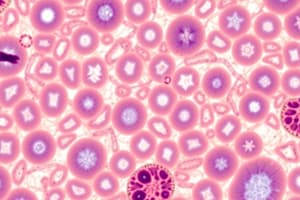Podcast
Questions and Answers
What are the four basic types of tissues?
What are the four basic types of tissues?
- Muscular tissue (correct)
- Nervous tissue (correct)
- Connective tissue (correct)
- Epithelial tissue (correct)
What is a tissue?
What is a tissue?
A group of cells and their intercellular substance that operate together for a specific function.
What does a pathologist do?
What does a pathologist do?
Examines tissues (biopsies) to determine indications of disease.
Connective tissue is specialized for contraction to provide movement.
Connective tissue is specialized for contraction to provide movement.
What type of epithelium covers body surfaces?
What type of epithelium covers body surfaces?
What does glandular epithelium make up?
What does glandular epithelium make up?
What is the free (unattached) surface of surface epithelium exposed to?
What is the free (unattached) surface of surface epithelium exposed to?
What does simple squamous epithelium line?
What does simple squamous epithelium line?
The top layer of stratified squamous epithelium is ___ shaped.
The top layer of stratified squamous epithelium is ___ shaped.
What characterizes pseudostratified epithelium?
What characterizes pseudostratified epithelium?
Flashcards are hidden until you start studying
Study Notes
Tissues
- Tissues are groups of cells working together for a specific purpose.
- Histology studies tissues microscopically.
- Pathologists examine tissues for disease indicators.
Types of Tissues
- Four basic tissue types: epithelial, connective, muscular, and nervous.
- Epithelial tissue covers surfaces, lines organs/cavities/ducts, and forms glands.
- Connective tissue protects and supports, binds organs, stores energy, and provides immunity.
- Muscular tissue contracts for movement and heat generation.
- Nervous tissue detects changes and responds with nerve impulses.
Epithelial Tissue
- Types: Surface epithelium (covers) and glandular epithelium (secreting glands)
- Surface epithelium is tightly packed with little intercellular substance.
- Arranged in single or multiple layers.
- Avascular (no blood vessels), but has nerves.
- Regenerative, attached to connective tissue via a basement membrane.
- Simple epithelium: single layer, functions in diffusion, osmosis, secretion, and absorption.
- Stratified epithelium: multiple layers, protective in high wear areas.
- Pseudostratified epithelium: single layer that appears stratified due to nuclei alignment, all cells attach to the basement membrane.
- Cell shapes: squamous (flat), cuboidal (cube-shaped), columnar (rectangular), and transitional (variable).
- Columnar cells have cilia or microvilli.
- Transitional cells change shape with organ relaxation/stretching.
- Glandular epithelium: found in glands (skin, digestive, endocrine).
- Exocrine glands: release products via ducts (e.g., salivary, sweat).
- Endocrine glands: ductless, release hormones into the bloodstream (e.g., thyroid, pituitary).
Classification of Epithelium
- Based on layers and cell shape.
- Simple Epithelium:
- Squamous: lining cardiovascular/lymphoid systems, serous membranes, alveoli. Functions in filtration, diffusion, secretion.
- Endothelium: lines heart, blood vessels, lymphatic vessels.
- Mesothelium: found in serous membranes.
- Cuboidal: covers ovaries, lines the lens, forms retinal epithelium.
- Columnar: one layer of rectangular cells.
- Nonciliated: lacks cilia, contains microvilli.
- Ciliated: contains cilia.
- Pseudostratified columnar: may be ciliated or nonciliated.
- Squamous: lining cardiovascular/lymphoid systems, serous membranes, alveoli. Functions in filtration, diffusion, secretion.
- Stratified Epithelium:
- Squamous: multiple layers, flat top layer.
- Nonkeratinized: lacks keratin.
- Keratinized: contains keratin.
- Cuboidal: multiple layers, cube-shaped top layer.
- Columnar: multiple layers, rectangular top layer.
- Urothelium (transitional): cells change shape based on organ form.
- Squamous: multiple layers, flat top layer.
Functions of Epithelium
- Protection, secretion, absorption, and excretion.
Studying That Suits You
Use AI to generate personalized quizzes and flashcards to suit your learning preferences.




